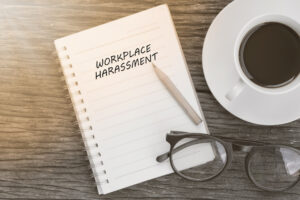
Workplace harassment concept on notebook with glasses, pencil and coffee cup on wooden table. Business concept.
In the modern workplace, where diversity and inclusivity are increasingly recognized and valued, it’s disheartening that workplace harassment remains a prevalent issue. Harassment at work can manifest in various forms, from subtle microaggressions to overt discrimination, creating not only an uncomfortable environment for employees but also a legal minefield for employers.
Understanding the legalities of workplace harassment and knowing your rights are essential steps toward addressing and rectifying these issues. At PLBH, we are committed to guiding victims of workplace harassment through the legal process to ensure justice and compensation for the wrongs they have endured. Contact us at (800) 435-7542 for a free legal consultation.
Understanding Workplace Harassment
Workplace harassment extends beyond the common misconception of sexual harassment to include religious, racial, age, gender, identity, sexual orientation, disability, and other forms of harassment. It’s critical to recognize that harassment encompasses any unwanted conduct based on these characteristics that either violate an individual’s dignity or create an intimidating, hostile, degrading, humiliating, or offensive environment.
Not all unpleasant interactions qualify as harassment, however. For conduct to be legally considered harassment, it must be repetitive or severe enough to constitute a hostile work environment. This means a single comment or isolated incident, unless exceptionally severe, might not meet the legal threshold for harassment. Yet, this does not diminish the importance of addressing and documenting every instance, as a pattern of behavior could establish the groundwork for legal action.
Your Rights and Steps to Take
Victims of workplace harassment have rights protected under both federal and state laws. In Southern California, as in much of the United States, employees are encouraged to take certain steps if they believe they are being harassed:
- Report the Harassment: It’s imperative to report the harassment to a supervisor, the HR department, or any designated officer within the organization. Keeping a copy of any written complaint is crucial for documentation purposes. Sometimes, an employer’s liability hinges on whether they were made aware of the harassment and their response to it.
- Document Everything: Keep a detailed record of all incidents of harassment, including dates, times, what was said or done, and witnesses. This documentation is vital for building a strong case should legal action be necessary.
- Contact an Attorney: Consulting with an experienced employment law attorney can provide you with a clear understanding of your rights and the best course of action. At PLBH, our team is ready to offer confidential advice and aggressively pursue the justice and compensation you deserve, often on a contingency fee basis, meaning you don’t pay unless we win your case.
Why Act Now?
Taking immediate action against workplace harassment is not just about seeking redress for personal grievances; it’s about contributing to a broader cultural shift towards safer and more respectful work environments. By standing up against harassment, you set a precedent that such behavior is unacceptable and legally actionable.
At PLBH, we believe in your right to a harassment-free workplace and are dedicated to fighting alongside you to achieve it. Our expertise in handling a wide array of harassment cases, combined with a compassionate and aggressive approach to litigation, positions us uniquely to support you through this challenging time.
Ready to Discuss Your Case?
If you’re seeking legal advice or representation regarding workplace harassment, PLBH is here to help. Contact us today at (800) 435-7542 for a free consultation. Remember, you’re not alone, and you have the right to work in an environment free from harassment and discrimination. Let’s take the first step towards securing that right together.
